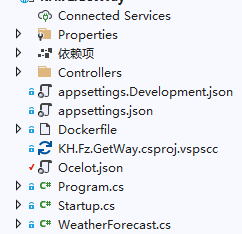Ocelot 是干啥的啊?如果是面试的话,面试官肯定要问,请说下你对ocelot的理解,或者是问请简单的聊下ocelot;
ocelot 下载: https://gitee.com/mirrors/ocelot-gateway
1、Ocelot是一个用.NET Core实现并且开源的API网关,它功能强大,强大的很啊。。。哈哈反正如果是面试的时候就吹呗,但是不要浮夸,ocelot
包括了:路由功能、请求聚合、服务发现、认证、鉴权、限流熔断、并内置了负载均衡器与Service Fabric、Butterfly Tracing集成。这些功能只都只需要简单的配置即可 ;
2、简单的来说Ocelot是asp.net core middleware组成的一个管道。当它拿到请求之后会用一个request builder来构造一个HttpRequestMessage发到下游的服务器,等下游的服务返回response之后再由一个middleware将它返回的HttpResponseMessage映射到HttpResponse上,相当于反向代理一下;
如果你有很多api你完全可以使用这个网关作为唯一的入口,一个域名多个URL即可,当然后流量多一定要用集群,因为这是唯一的入口啊所有的请求都从这过,如果是大型项目的话针对不同的微服务做一个单独的集群,这也是和nginx的区别做多个集群做服务治理;

他与Nginx的对比:
【Ocelot和Nginx的共同点】
反向代理,地址转发
负载均衡
【不同点】
Nginx由一个集群组成。主要优点高性能,高吞吐,安全
Ocelot 由多个集群组成。本质是为了做路由(多组地址转发),实现服务治理
下面开始实现一个小集群。

1、先创建3个netcore web站点或者是3个api 里面的内容改下 ,我这就是app1/2/3

2、创建好之后在启动下。 分别到3个服务的跟目录cmd 然后用命令启动 :
dotnet run --urls="http://*:5051" /port=5051
dotnet run --urls="http://*:5052" /port=5052
dotnet run --urls="http://*:5053" /port=5053
3、开始创建网关 :
创建一个api的项目

4、然后在Startup里把管道啥的都干掉,Nuget添加Ocelot引用

using Microsoft.AspNetCore.Builder;
using Microsoft.AspNetCore.Hosting;
using Microsoft.AspNetCore.HttpsPolicy;
using Microsoft.AspNetCore.Mvc;
using Microsoft.Extensions.Configuration;
using Microsoft.Extensions.DependencyInjection;
using Microsoft.Extensions.Hosting;
using Microsoft.Extensions.Logging;
using Microsoft.OpenApi.Models;
using System;
using System.Collections.Generic;
using System.Linq;
using System.Threading.Tasks;
using Ocelot.DependencyInjection;
using Ocelot.Middleware;
using Ocelot.Provider.Consul;
using Ocelot.Provider.Polly;
namespace KH.Fz.GetWay
{
public class Startup
{
public Startup(IConfiguration configuration)
{
Configuration = configuration;
}
public IConfiguration Configuration { get; }
// This method gets called by the runtime. Use this method to add services to the container.
public void ConfigureServices(IServiceCollection services)
{
services.AddOcelot(); //.AddConsul().AddPolly();
}
// This method gets called by the runtime. Use this method to configure the HTTP request pipeline.
public void Configure(IApplicationBuilder app, IWebHostEnvironment env)
{
app.UseOcelot().Wait();
}
}
}
5、然后添加配置文件
public class Program
{
public static void Main(string[] args)
{
CreateHostBuilder(args).Build().Run();
}
public static IHostBuilder CreateHostBuilder(string[] args) =>
Host.CreateDefaultBuilder(args)
.ConfigureAppConfiguration((hostingContext, builder) => {
builder.SetBasePath(hostingContext.HostingEnvironment.ContentRootPath).AddJsonFile("Ocelot.json");
})
.ConfigureWebHostDefaults(webBuilder =>
{
webBuilder.UseStartup<Startup>();
});
}
6、配置文件的配置: Routes 高版本和低版本的写法不一样 老版本加Re 要不不显示 这有坑:
{
"Routes": [
{
"DownstreamPathTemplate": "/{url}",
"DownstreamScheme": "http",
"DownstreamHostAndPorts": [
{
"Host": "localhost",
"Port": 5053
}
],
"UpstreamPathTemplate": "/v3/{url}",
"UpstreamHttpMethod": [
"Get",
"Post"
],
"LoadBalancerOptions": {
"Type": "RoundRobin" //轮询 , 还有一种是空闲分配 https://www.freesion.com/article/53741280560/
}
},
{
"DownstreamPathTemplate": "/{url}",
"DownstreamScheme": "http",
"DownstreamHostAndPorts": [
{
"Host": "localhost",
"Port": 5052
}
],
"UpstreamPathTemplate": "/v2/{url}",
"UpstreamHttpMethod": [
"Get",
"Post"
],
"LoadBalancerOptions": {
"Type": "RoundRobin" //轮询 , 还有一种是空闲分配 https://www.freesion.com/article/53741280560/
}
},
{
"DownstreamPathTemplate": "/{url}",
"DownstreamScheme": "http",
"DownstreamHostAndPorts": [
{
"Host": "localhost",
"Port": 5051
}
],
"UpstreamPathTemplate": "/v1/{url}",
"UpstreamHttpMethod": [
"Get",
"Post"
],
"LoadBalancerOptions": {
"Type": "RoundRobin" //轮询 , 还有一种是空闲分配
}
}
],
// 全局配置,此节点的配置会覆盖Routes,可以在这里设置一些通用的配置
"GlobalConfiguration": {
"ReRouteIsCaseSensitive": false // 路由是否区分大小写
}
}
{
"Routes": [
{
"DownstreamPathTemplate": "/{url}",
"DownstreamScheme": "http",
"DownstreamHostAndPorts": [
{
"Host": "localhost",
"Port": 5053
},
{
"Host": "localhost",
"Port": 5052
},
{
"Host": "localhost",
"Port": 5051
},
],
"UpstreamPathTemplate": "/v3/{url}",
"UpstreamHttpMethod": [
"Get",
"Post"
],
"LoadBalancerOptions": {
"Type": "RoundRobin" //轮询 , 还有一种是空闲分配 https://www.freesion.com/article/53741280560/
}
}
}
7、配置文件一般一看就知道咋回事了;
UpstreamPathTemplate 上行,也就是请求路径,{url}是请求路由
UpstreamHttpMethod 支持的请求方式
DownstreamPathTemplate 请求Kestrel的地址,也就是说请求你的真实项目的地址
DownstreamScheme http还是https
DownstreamHostAndPorts 这个就是host和port了。
LoadBalancerOptions:有这三个机制 一般用第一个或者第二个;
RoundRobin:轮询机制,循环找到可以用的服务
LeastConnection:最少连接数,跟踪发现现在有最少请求或处理的可用服务
NoLoadBalancer:不使用负载均衡,直接访问config配置或者服务发现的第一个可用服务
大坑:如果consul注册发现中心和web节点在通一台机器上的话 他找的不是ip而是 hostname+port模式所以经常会报错: 非法的主机名 或者主机名不对。 这是个大坑请大家注意
上面是两种配置方法,大家注意啊。如果服务一样而且负载的话就用第2种就行了。
这个整完了 就可以跑了
下一篇请点击:
微服务治理(Ocelot)- 2





















 978
978











 被折叠的 条评论
为什么被折叠?
被折叠的 条评论
为什么被折叠?








